seat adjustment RENAULT ALASKAN 2017 Owners Manual
[x] Cancel search | Manufacturer: RENAULT, Model Year: 2017, Model line: ALASKAN, Model: RENAULT ALASKAN 2017Pages: 340, PDF Size: 6.93 MB
Page 5 of 340
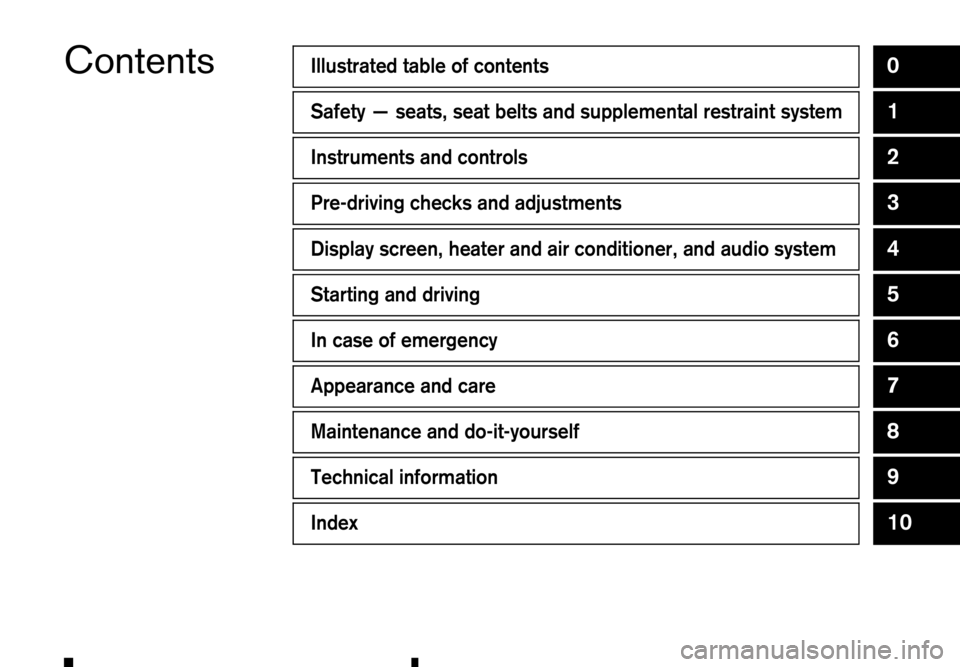
ContentsIllustrated table of contents0
Safety
—seats, seat belts and supplemental restraint system1
Instruments and controls2
Pre-driving checks and adjustments3
Display screen, heater and air conditioner, and audio system4
Starting and driving5
In case of emergency6
Appearance and care7
Maintenance and do-it-yourself8
Technical information9
Index10
Page 20 of 340
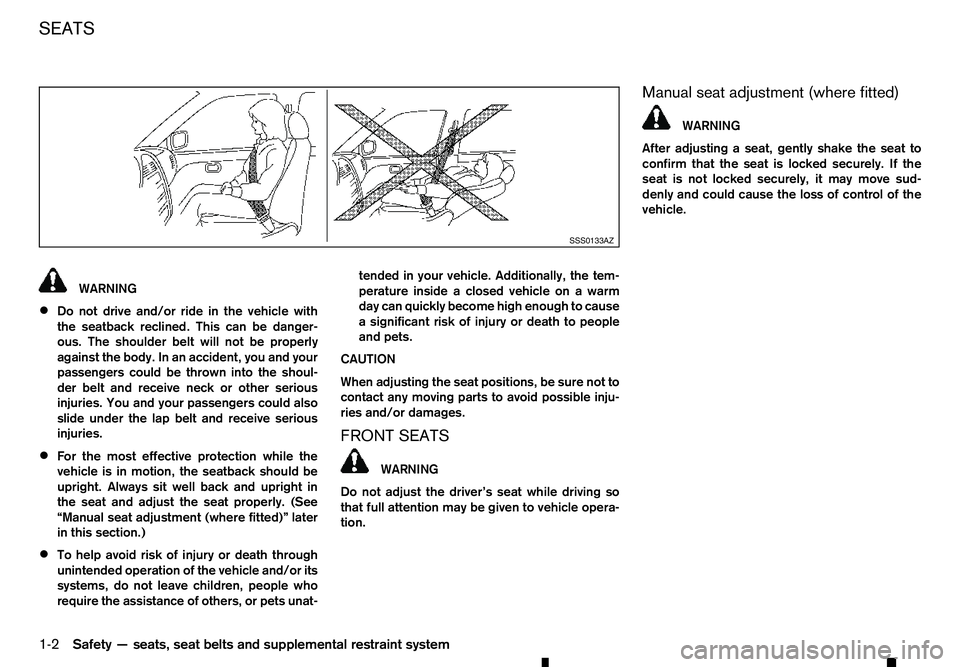
WARNING
• Do not drive and/or ride in the vehicle with
the seatback reclined. This can be danger-
ous. The shoulder belt will not be properly
against the body. In an accident, you and your
passengers could be thrown into the shoul-
der belt and receive neck or other serious
injuries. You and your passengers could also
slide under the lap belt and receive serious
injuries.
• For the most effective protection while the
vehicle is in motion, the seatback should be
upright. Always sit well back and upright in
the seat and adjust the seat properly. (See
“Manual seat adjustment (where fitted)” later
in this section.)
• To help avoid risk of injury or death through
unintended operation of the vehicle and/or its
systems, do not leave children, people who
require the assistance of others, or pets unat- tended in your vehicle. Additionally, the tem-
perature inside
aclosed vehicle on awarm
day can quickly become high enough to cause
as ignificant risk of injury or death to people
and pets.
CAUTION
When adjusting the seat positions, be sure not to
contact any moving parts to avoid possible inju-
ries and/or damages.
FRONT SEATS WARNING
Do not adjust the driver’s seat while driving so
that full attention may be given to vehicle opera-
tion. Manual seat adjustment (where fitted) WARNING
After adjusting
aseat, gently shake the seat to
confirm that the seat is locked securely. If the
seat is not locked securely, it may move sud-
denly and could cause the loss of control of the
vehicle. SSS0133AZ
SEATS
1-2
Safety —seats, seat belts and supplemental restraint system
Page 21 of 340
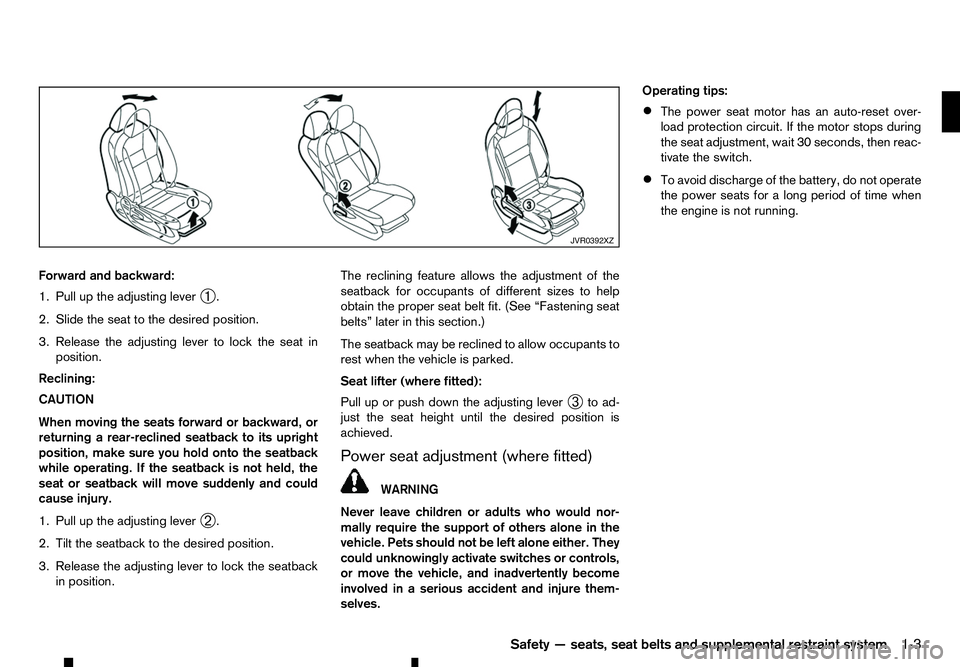
Forward and backward:
1. Pull up the adjusting lever ➀.
2. Slide the seat to the desired position.
3. Release the adjusting lever to lock the seat in position.
Reclining:
CAUTION
When moving the seats forward or backward, or
returning arear-reclined seatback to its upright
position, make sure you hold onto the seatback
while operating. If the seatback is not held, the
seat or seatback will move suddenly and could
cause injury.
1. Pull up the adjusting lever ➁.
2. Tilt the seatback to the desired position.
3. Release the adjusting lever to lock the seatback in position. The reclining feature allows the adjustment of the
seatback for occupants of different sizes to help
obtain the proper seat belt fit. (See “Fastening seat
belts” later in this section.)
The seatback may be reclined to allow occupants to
rest when the vehicle is parked.
Seat lifter (where fitted):
Pull up or push down the adjusting lever ➂to ad-
just the seat height until the desired position is
achieved.
Power seat adjustment (where fitted) WARNING
Never leave children or adults who would nor-
mally require the support of others alone in the
vehicle. Pets should not be left alone either. They
could unknowingly activate switches or controls,
or move the vehicle, and inadvertently become
involved in aserious accident and injure them-
selves. Operating tips:
• The power seat motor has an auto-reset over-
load protection circuit. If the motor stops during
the seat adjustment, wait 30 seconds, then reac-
tivate the switch.
• To avoid discharge of the battery, do not operate
the power seats for
along period of time when
the engine is not running. JVR0392XZ
Safety —seats, seat belts and supplemental restraint system
1-3
Page 22 of 340
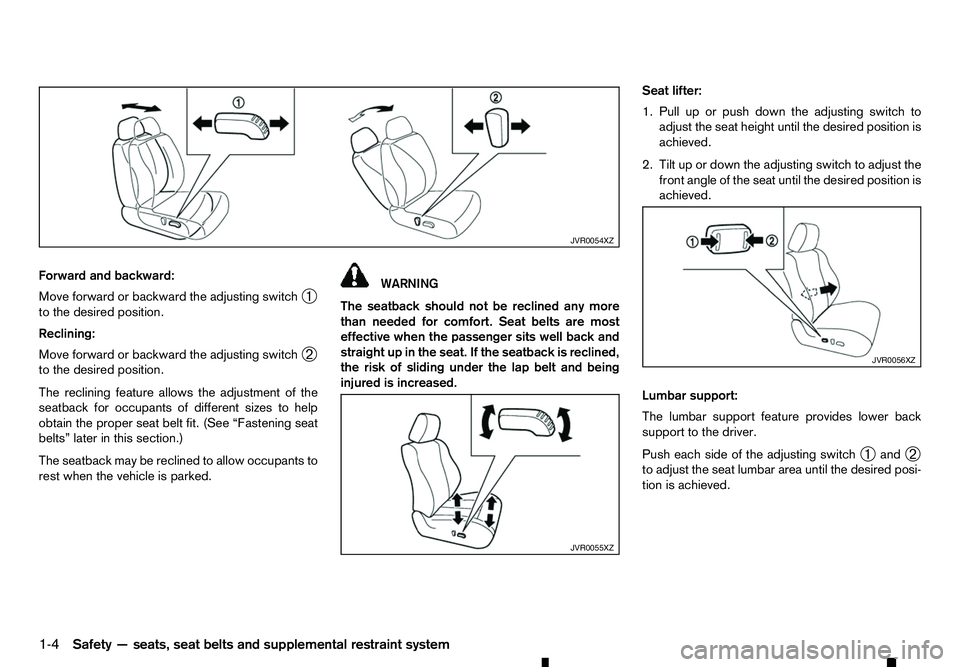
Forward and backward:
Move forward or backward the adjusting switch ➀
to the desired position.
Reclining:
Move forward or backward the adjusting switch ➁
to the desired position.
The reclining feature allows the adjustment of the
seatback for occupants of different sizes to help
obtain the proper seat belt fit. (See “Fastening seat
belts” later in this section.)
The seatback may be reclined to allow occupants to
rest when the vehicle is parked. WARNING
The seatback should not be reclined any more
than needed for comfort. Seat belts are most
effective when the passenger sits well back and
straight up in the seat. If the seatback is reclined,
the risk of sliding under the lap belt and being
injured is increased. Seat lifter:
1. Pull up or push down the adjusting switch to
adjust the seat height until the desired position is
achieved.
2. Tilt up or down the adjusting switch to adjust the front angle of the seat until the desired position is
achieved.
Lumbar support:
The lumbar support feature provides lower back
support to the driver.
Push each side of the adjusting switch ➀and
➁
to adjust the seat lumbar area until the desired posi-
tion is achieved. JVR0054XZ
JVR0055XZ JVR0056XZ
1-4 Safety —seats, seat belts and supplemental restraint system
Page 24 of 340
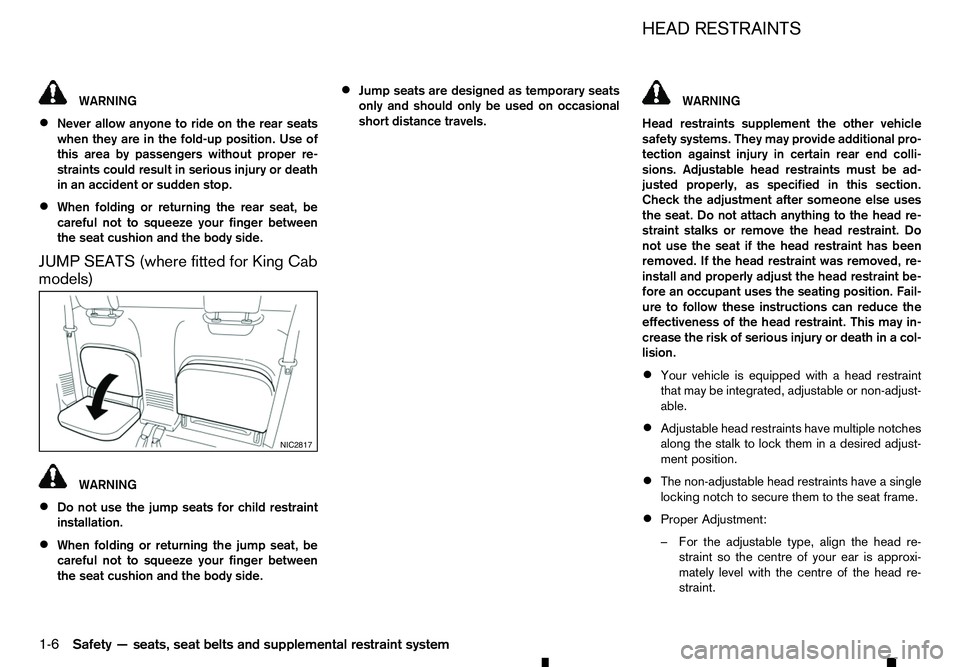
WARNING
• Never allow anyone to ride on the rear seats
when they are in the fold-up position. Use of
this area by passengers without proper re-
straints could result in serious injury or death
in an accident or sudden stop.
• When folding or returning the rear seat, be
careful not to squeeze your finger between
the seat cushion and the body side.
JUMP SEATS (where fitted for King Cab
models) WARNING
• Do not use the jump seats for child restraint
installation.
• When folding or returning the jump seat, be
careful not to squeeze your finger between
the seat cushion and the body side. •
Jump seats are designed as temporary seats
only and should only be used on occasional
short distance travels. WARNING
Head restraints supplement the other vehicle
safety systems. They may provide additional pro-
tection against injury in certain rear end colli-
sions. Adjustable head restraints must be ad-
justed properly, as specified in this section. Check the adjustment after someone else uses
the seat. Do not attach anything to the head re-
straint stalks or remove the head restraint. Do
not use the seat if the head restraint has been
removed. If the head restraint was removed, re-
install and properly adjust the head restraint be-
fore an occupant uses the seating position. Fail-
ure to follow these instructions can reduce the
effectiveness of the head restraint. This may in-
crease the risk of serious injury or death in acol-
lision.
• Your vehicle is equipped with
ahead restraint
that may be integrated, adjustable or non-adjust-
able.
• Adjustable head restraints have multiple notches
along the stalk to lock them in
adesired adjust-
ment position.
• The non-adjustable head restraints have
asingle
locking notch to secure them to the seat frame.
• Proper Adjustment:
–F
or the adjustable type, align the head re-
straint so the centre of your ear is approxi-
mately level with the centre of the head re-
straint. NIC2817 HEAD RESTRAINTS
1-6 Safety —seats, seat belts and supplemental restraint system
Page 30 of 340
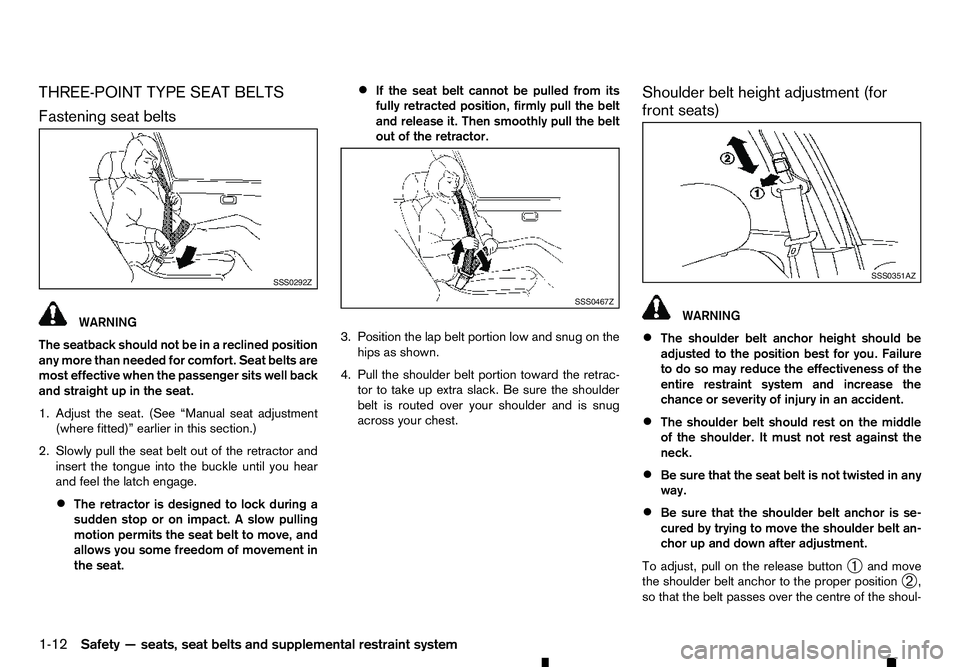
THREE-POINT TYPE SEAT BELTS
Fastening seat belts WARNING
The seatback should not be in
areclined position
any more than needed for comfort. Seat belts are
most effective when the passenger sits well back
and straight up in the seat.
1. Adjust the seat. (See “Manual seat adjustment
(where fitted)” earlier in this section.)
2. Slowly pull the seat belt out of the retractor and insert the tongue into the buckle until you hear
and feel the latch engage.
• The retractor is designed to lock during a
sudden stop or on impact.
Aslow pulling
motion permits the seat belt to move, and
allows you some freedom of movement in
the seat. •
If the seat belt cannot be pulled from its
fully retracted position, firmly pull the belt
and release it. Then smoothly pull the belt
out of the retractor.
3. Position the lap belt portion low and snug on the hips as shown.
4. Pull the shoulder belt portion toward the retrac- tor to take up extra slack. Be sure the shoulder
belt is routed over your shoulder and is snug
across your chest. Shoulder belt height adjustment (for
front seats) WARNING
• The shoulder belt anchor height should be
adjusted to the position best for you. Failure
to do so may reduce the effectiveness of the
entire restraint system and increase the
chance or severity of injury in an accident.
• The shoulder belt should rest on the middle
of the shoulder. It must not rest against the
neck.
• Be sure that the seat belt is not twisted in any
way.
• Be sure that the shoulder belt anchor is se-
cured by trying to move the shoulder belt an-
chor up and down after adjustment.
To adjust, pull on the release button ➀and move
the shoulder belt anchor to the proper position ➁,
so that the belt passes over the centre of the shoul- SSS0292Z
SSS0467Z SSS0351AZ
1-12 Safety —seats, seat belts and supplemental restraint system
Page 32 of 340
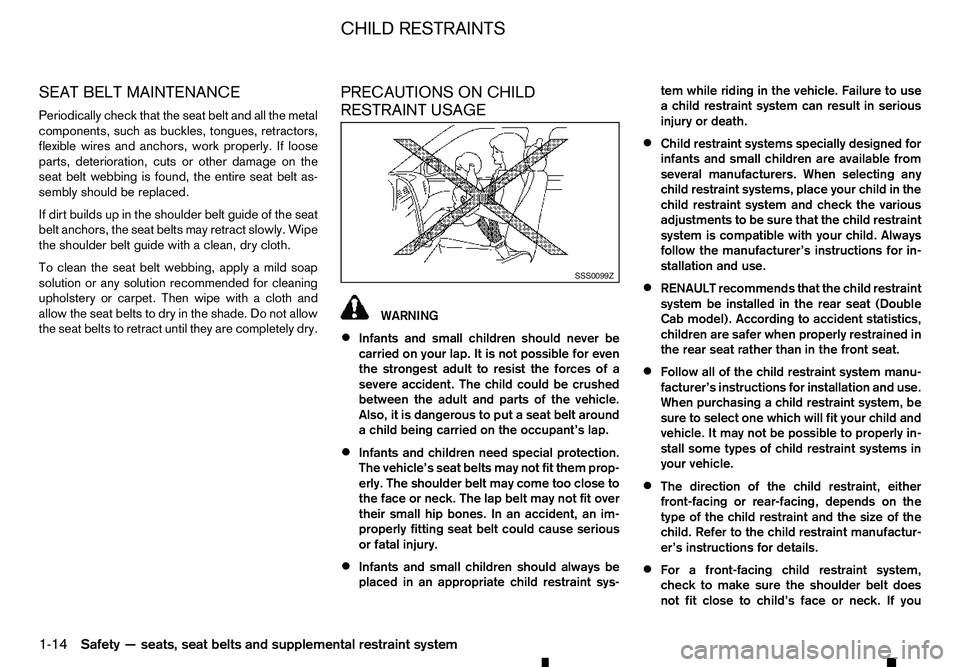
SEAT BELT MAINTENANCE
Periodically check that the seat belt and all the metal
components, such as buckles, tongues, retractors,
flexible wires and anchors, work properly. If loose
parts, deterioration, cuts or other damage on the
seat belt webbing is found, the entire seat belt as-
sembly should be replaced.
If dirt builds up in the shoulder belt guide of the seat
belt anchors, the seat belts may retract slowly. Wipe
the shoulder belt guide with aclean, dry cloth.
To clean the seat belt webbing, apply amild soap
solution or any solution recommended for cleaning
upholstery or carpet. Then wipe with acloth and
allow the seat belts to dry in the shade. Do not allow
the seat belts to retract until they are completely dry. PRECAUTIONS ON CHILD
RESTRAINT USAGE WARNING
• Infants and small children should never be
carried on your lap. It is not possible for even
the strongest adult to resist the forces of a
severe accident. The child could be crushed
between the adult and parts of the vehicle.
Also, it is dangerous to put aseat belt around
ac hild being carried on the occupant’s lap.
• Infants and children need special protection.
The vehicle’s seat belts may not fit them prop-
erly. The shoulder belt may come too close to
the face or neck. The lap belt may not fit over
their small hip bones. In an accident, an im-
properly fitting seat belt could cause serious
or fatal injury.
• Infants and small children should always be
placed in an appropriate child restraint sys- tem while riding in the vehicle. Failure to use
ac
hild restraint system can result in serious
injury or death.
• Child restraint systems specially designed for
infants and small children are available from
several manufacturers. When selecting any
child restraint systems, place your child in the
child restraint system and check the various
adjustments to be sure that the child restraint
system is compatible with your child. Always
follow the manufacturer’s instructions for in-
stallation and use.
• RENAULT recommends that the child restraint
system be installed in the rear seat (Double
Cab model). According to accident statistics,
children are safer when properly restrained in
the rear seat rather than in the front seat.
• Follow all of the child restraint system manu-
facturer’s instructions for installation and use.
When purchasing
achild restraint system, be
sure to select one which will fit your child and
vehicle. It may not be possible to properly in- stall some types of child restraint systems in
your vehicle.
• The direction of the child restraint, either
front-facing or rear-facing, depends on the
type of the child restraint and the size of the child. Refer to the child restraint manufactur-
er’s instructions for details.
• For
afront-facing child restraint system,
check to make sure the shoulder belt does
not fit close to child’s face or neck. If you SSS0099Z
CHILD RESTRAINTS
1-14 Safety —seats, seat belts and supplemental restraint system
Page 33 of 340

must install
afront-facing child restraint sys-
tem in the front seat, see “Installation on front
passenger’s seat” later in this section.
• Never install
arear-facing child restraint sys-
tem on the front passenger’s seat when the
front passenger’s air bag is active. Supple- mental front-impact air bags inflate with great
force. Arear-facing child restraint system
could be struck by the supplemental front-im-
pact air bags in an accident and could seri-
ously injure or kill your child.
• Do not install
achild restraint in the jump seats
(where fitted for King Cab model). These
seats are not suitable for child restraint instal-
lation.
• Adjustable seatbacks should be positioned to
fit
ac hild restraint system, but as upright as
possible. see “Installation on rear outboard
seats” later in this section and “Child restraint
installation using three-point type seat belt”
later in this section.
• If the seat belt in the position where
achild
restraint system is installed requires alocking
clip and if it is not used, injuries could result
from achild restraint system tipping over dur-
ing normal vehicle braking or cornering.
• After attaching
achild restraint system, test it
before you place the child in it. Tilt it from side
to side. Try to tug it forward and check if it is
held securely in place. The child restraint sys-
tem should not move more than 25 mm (1 in). If the restraint is not secure, tighten the belt
as necessary, or install the restraint in another
seat and test it again.
• Check the child restraint system in your ve-
hicle to be sure that it is compatible with the
vehicle’s seat belt system.
• If
ac hild restraint system is not anchored
properly, the risk of achild being injured in a
collision or asudden stop greatly increases.
• Improper use of
achild restraint system can
increase the risk or severity of injury for both
the child and other occupants in the vehicle.
• Always use an appropriate child restraint sys-
tem. An improperly installed child restraint
system could lead to serious injury or death in
an accident.
• When the child restraint system is not in use,
keep it secured with the ISOFIX and i-Size
child restraint system or
aseat belt to prevent
it from being thrown around in case of asud-
den stop or accident.
RENAULT recommends that infants and small chil-
dren be seated in achild restraint system. You
should choose achild restraint system that fits your
vehicle and always follow the manufacturer’s in-
structions for installation and use. In addition, there
are many types of child restraint systems available
for larger children that should be used for maximum
protection. CAUTION
Remember that
achild restraint system left in a
closed vehicle can become very hot. Check the
seating surface and buckles before placing your
child in achild restraint system.
UNIVERSAL CHILD RESTRAINTS FOR
FRONT SEAT AND REAR SEATS (for
Europe)
NOTE
Child restraints approved to UN Regulation No.
44 or No. 129 are clearly marked with the catego-
ries such as Universal, Semi-universal or ISOFIX.
When selecting any child restraint, keep the follow-
ing points in mind:
• Choose
achild restraint that complies with the
latest European safety standard, UN Regulation
No. 44 or No. 129.
• Place your child in the child restraint and check
the various adjustments to be sure the child re-
straint is compatible with your child. Always fol-
low all of the recommended procedures.
• Check the child restraint in your vehicle to be
sure it is compatible with vehicle’s retention sys-
tem.
• Refer to the tables later in this section for
alist of
the recommended fitment positions and the ap-
proved child restraints for your vehicle.
Safety —seats, seat belts and supplemental restraint system 1-15
Page 35 of 340
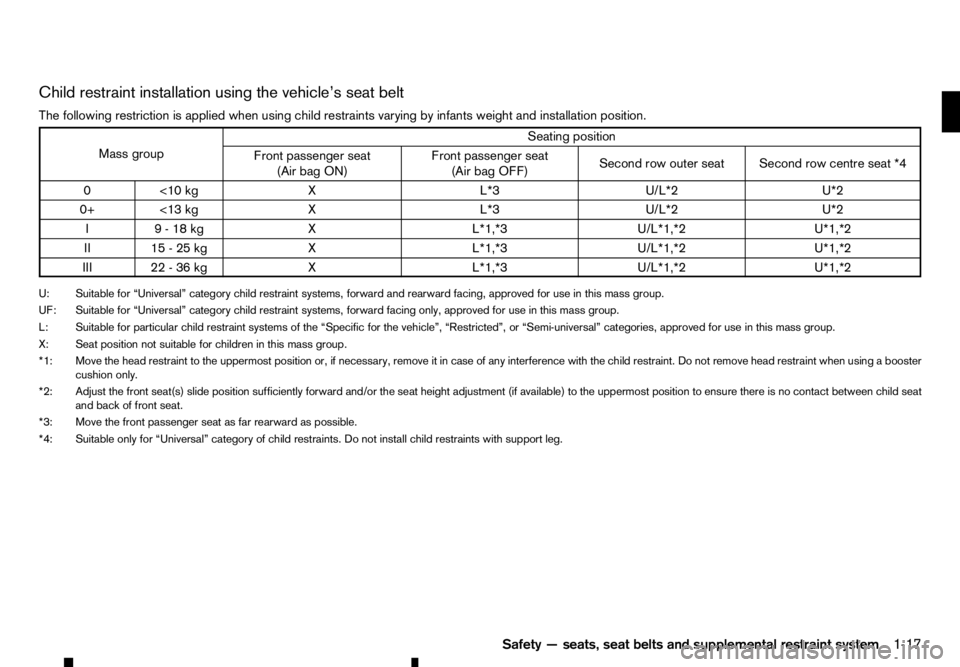
Child restraint installation using the vehicle’s seat belt
The following restriction is applied when using child restraints varying by infants weight and installation position. Mass group
Seating position
Front passenger seat (Air bag ON) Front passenger seat
(Air bag OFF) Second row outer seat Second row centre seat *4
0< 10 kg XL *3U/L*2 U*2
0+ <13 kg XL *3U/L*2 U*2
I9 -18kgX L*1,*3U/L*1,*2 U*1,*2
II 15 -25kgX L*1,*3U/L*1,*2 U*1,*2
III 22 -36kgX L*1,*3U/L*1,*2 U*1,*2
U: Suitable for “Universal” category child restraint systems, forward and rearward facing, approved for use in this mass group.
UF: Suitable for “Universal” category child restraint systems, forward facing only, approved for use in this mass group.
L: Suitable for particular child restraint systems of the “Specific for the vehicle”, “Restricted”, or “Semi-universal” categories, approved for use in this mass group. X: Seat position not suitable for children in this mass group.
*1: Move the head restraint to the uppermost position or, if necessary, remove it in case of any interference with the child restraint. Do not remove head restraint when using abooster
cushion only.
*2: Adjust the front seat(s) slide position sufficiently forward and/or the seat height adjustment (if available) to the uppermost position to ensure there is no contact between child seat and back of front seat.
*3: Move the front passenger seat as far rearward as possible.
*4: Suitable only for “Universal” category of child restraints. Do not install child restraints with support leg.
Safety—seats, seat belts and supplemental restraint system 1-17
Page 36 of 340
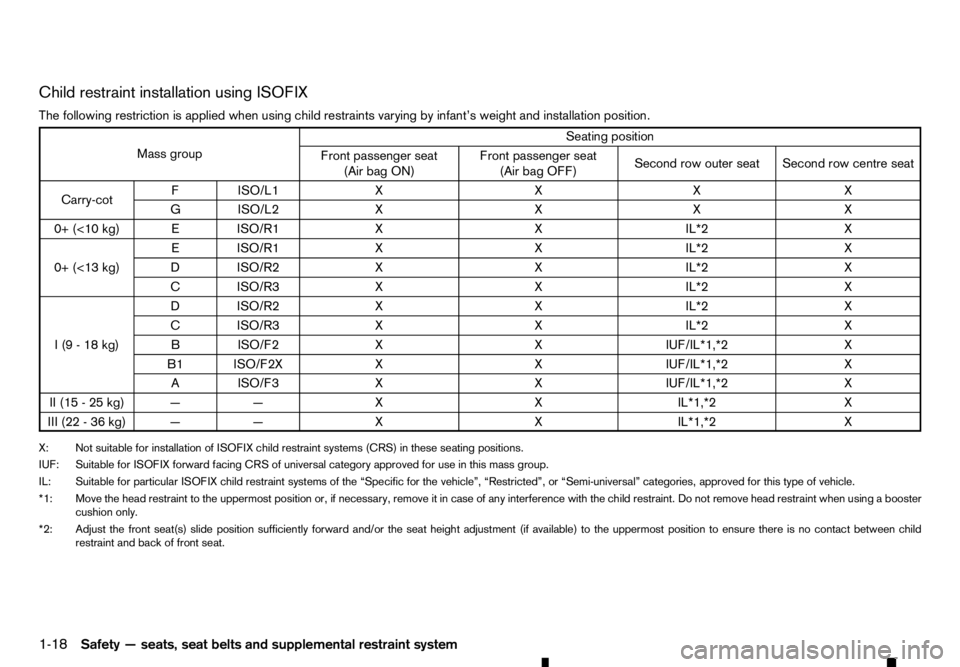
Child restraint installation using ISOFIX
The following restriction is applied when using child restraints varying by infant’s weight and installation position. Mass group
Seating position
Front passenger seat (Air bag ON) Front passenger seat
(Air bag OFF) Second row outer seat Second row centre seat
Carry-cot FI
SO/L1 XX XX
GI SO/L2 XX XX
0+ (<10 kg) EISO/R1 XX IL*2X
0+ (<13 kg) EI
SO/R1 XX IL*2X
DI SO/R2 XX IL*2X
CI SO/R3 XX IL*2X
I(9-18k g) DI
SO/R2 XX IL*2X
CI SO/R3 XX IL*2X
BI SO/F2 XX IUF/IL*1,*2X
B1 ISO/F2X XX IUF/IL*1,*2X
AI SO/F3 XX IUF/IL*1,*2X
II (15 -25kg) —— XX IL*1,*2X
III (22 -36kg) —— XX IL*1,*2X
X: Not suitable for installation of ISOFIX child restraint systems (CRS) in these seating positions.
IUF: Suitable for ISOFIX forward facing CRS of universal category approved for use in this mass group.
IL: Suitable for particular ISOFIX child restraint systems of the “Specific for the vehicle”, “Restricted”, or “Semi-universal” categories, approved for this type of vehicle.
*1: Move the head restraint to the uppermost position or, if necessary, remove it in case of any interference with the child restraint. Do not remove head restraint when using abooster
cushion only.
*2: Adjust the front seat(s) slide position sufficiently forward and/or the seat height adjustment (if available) to the uppermost position to ensure there is no contact between child restraint and back of front seat.
1-18 Safety —seats, seat belts and supplemental restraint system